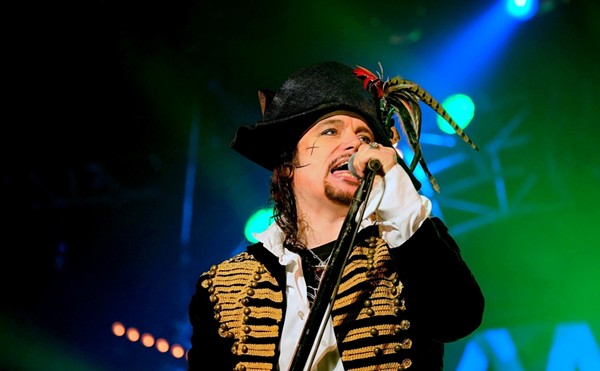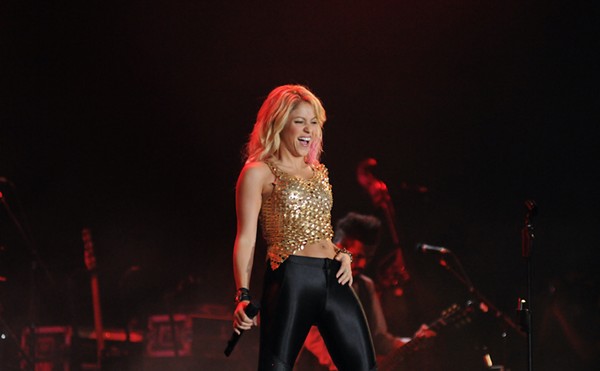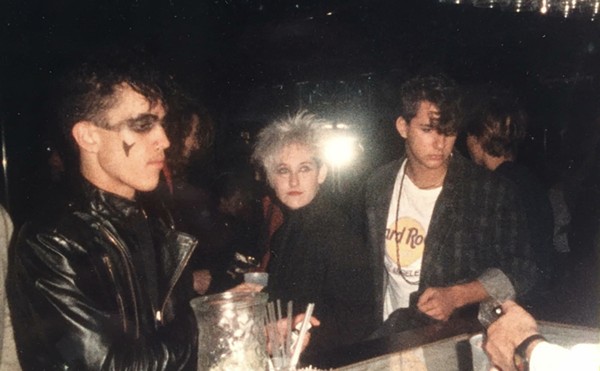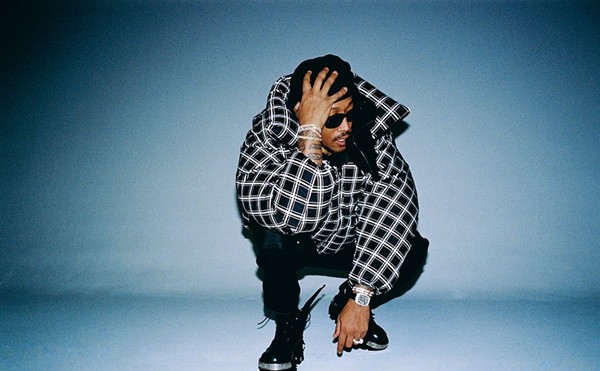Pick a day. Any day. Check out what bands are coming to, say, Austin. Then look to see what other cities they’ll be visiting. Most won’t be coming to San Antonio. They’ll go to Austin, Houston, Dallas. Even Edinburg. But SA? No way.
England’s Yuck played Austin, Dallas, Houston, and even Chapel Hill, N.C. No SA.
Penguin Prison went to Austin, Dallas, and Houston.
Matt White? Austin and Dallas.
Moondogies? Austin and Dallas; same as Destroyer.
Seattle’s The Head and The Heart prefer the triple treat: Austin, Houston, and Dallas. Fuck San Anto.
There are exceptions, of course. We Came As Romans put San Antonio on their to-do list. Mexico’s rock powerhouse Zoé hit SA’s Club Río last week. And Santana regularly plays both Austin and SA. As do the Misfits.
Just when you start feeling better about things, you read that the Robert Johnson Big Head Blues Club tour headed by Big Head Todd & The Monsters’ Todd Park Mohr went to Dallas and Austin but skipped the very city where Johnson recorded 16 of his 42 songs, arguably the most important recordings in the history of blues.
Worst of all: Arcade Fire played Austin, Houston, and Dallas earlier this year, and will return to Austin for Austin City Limits on September 18. Screw San Anto. The South By Southwest spill-over phenomenon won’t be happening then — most of ACL bands won’t be coming to SA.
Some say there are not enough people in San Antonio for Arcade Fire. Really? The seventh largest city in the U.S. doesn’t have enough people to see one of the best-loved bands in the world? We’re lamer than I thought. Perhaps we’ve been a “secondary market” operating in Austin’s shadow for too long. Or maybe, as some think, our promoters are just too cheap and lazy.
“Secondary markets have secondary-minded people, while primary markets have primary-minded people,” said a national booking agent from a major L.A. firm who asked to remain anonymous. “Almost every time I’m booking a tour, it’s easier to get Austin to react than it is San Antonio. It’s much easier to get a quality offer in Austin.”
Better venues with more money means “a better class of promoters,” he said. Better promoters put pressure on the clubs to up their game. “And the cycle grows.”
Austin, the L.A. promoter continued, “represents a number of large-scale festivals. Conversely, there are no major festivals in San Antonio that are on my radar.”
••••••••••••••••
It wasn’t always this way. Margaret Moser, long-time music writer for the Austin Chronicle, keeps at her desk a poster from 1969 that says it all. It features a cartoon drawing of the state of Texas as a woman holding two men labeled “San Antonio” and “Austin.” It reads: “Open Air Concert, Sunday, September 21. Austin and San Antonio are getting together at the Sunken Gardens Theater. From Austin — The New Atlantis and Plymouth Rock. From San Antonio — Virgil Foxx and Doobey.”
“Austin and San Antonio once had a very close relationship,” Moser told the Current. “In the ’60s, when this poster came out of, San Antonio’s rock scene was much, much stronger than Austin’s. Austin bands regularly came to San Antonio, much more so than the other way around.”
But then, San Antonio musicians began to move out. “Being the late ’60s and the early ’70s, let me tell you, every place was calling but Texas, pretty much,” Moser said. “People either ran off to California, like Doug Sahm did, or they went up to Austin … like Doug Sahm did!”
But before you start blaming Sahm, consider the politics (and cops) of the time. Says Texas Tornados’ Augie Meyers: “Yes, San Antonio used to be a stronger market, but Doug [Sahm] and I got tired of being busted for smoking pot. And many venues [in SA] stopped booking us because we were busted. L.A. and Austin in those days were freer than San Antonio, so people started moving out.”
In the time since, Austin has developed a strong sense of local music, which is reflected on the local dial. “On San Antonio radio I can’t get a sense of what San Antonio music is,” said Moser, “while Austin does very much support the sound of its town.”
Then there’s the infamous radius clause, which makes it hard for bands to play both towns. In fact, most touring acts playing Austin are not allowed to play anywhere within 90-300 miles, depending on whom you ask. Why is it, then, that Das Racist, scheduled to play San Marcos on October 27 and Austin the next day, was planning to skip San Antonio? I brought this up to Erica Vigliante, whose Twin Productions books touring bands at the White Rabbit, Sunset Station, Backstage Live, and other local venues. Days after we spoke, she had secured Das Racist for October 30 at the White Rabbit. Bingo! It is possible to book good shows in San Antonio. It only takes a little bit of extra effort, with or without the damn clause.
“Whenever I [tell booking agents], ‘Can I please get such-and-such band?’ it’s always the same answer: ‘No, they’re in Austin. There’s a radius clause.’ That has been engrained in my head in 15 years in this business: ‘There’s a radius clause. There’s a radius clause,’” said Vigliante.
C3, a major Austin concert production company, would not agree to an interview about the practice. Instead, they had a PR person refer us to another company. “C3 does not promote any shows/venues in the SA area, so it will be difficult for them to comment on this,” the flack said.
But even radius rules are not written in stone, as we saw with Sleigh Bells, who sold out Austin first and then nearly sold out the White Rabbit in April. “Oh, I begged for that show,” Vigliante said. “I begged.” Then she blamed politics for the state of affairs: “Anaheim and L.A., for example, are the mecca for labels, big managers, big business, and big promoters, so the tolerance to have shows that are close together is higher for those cities. Promoters in Anaheim and L.A. are very, very well connected.”
••••••••••••••••
There’s no logical reason why it couldn’t be the same here. Vigliante has been pushing the issue for years. “When I put my offer in, I don’t care if you played Austin,” she said. “You know why I don’t care? Because I have faith in San Antonio. We are the seventh largest city in the country. [Austin draws] from us. This has been engrained for years, because promoters in Austin started doing it before any of us promoters here started. This is a much, much bigger city. So Austin needs us. This is the crazy part about it. … People are trained to drive to Austin. Don’t go. Don’t go.”
San Antonians, it seems, need to stop and ask themselves: “Why can’t that band come here?” and then work to make it happen.
If Austin is holding San Antonio fans captive with this radius clause, why aren’t we organizing to turn the tables and force those bands to come here, instead? How much power do we really have?
Not much, according to Roland Fuentes, owner of Nightrocker Live and a contractor with Live Nation. “You’re talking about what, honestly? Twenty people, 50 people, 100 people going to Austin?” said Fuentes. “And maybe a little over 1,000 for a major show?” The numbers don’t support the argument.
But if Austin could survive without us, why is there a radius clause in the first place? It’s a combination of things: Major Austin promoters needlessly pissing on their territory like greedy cats, struggling SA promoters unable or unwilling to do the work necessary to dismantle the radius clause, and SA fans more willing to drive to Austin than attending local shows. “I’m sure Arcade Fire was willing to come to San Antonio, but they wouldn’t give up Austin to come play in San Antonio,” said Scott Andreu, owner of Texas is Funny Records and part of the Drunken Monkey Promotions team. “I can understand that.”
So can Fuentes.
“We’re a city of almost 2 million people, [but] the most people you can get for an Alamodome show or any kind of major rock show is 8,000 people, where everywhere else they’re doing 15,000 to 20,000,” said Fuentes. “And these baby bands, the club acts, they play elsewhere in the States for 500-800 people, but they come to San Antonio and do 100. Being a talent buyer, I can’t pay the prices that they command just an hour down the road.”
The turnout for recent shows by CJ Ramone at Nightrocker and Nashville Pussy at White Rabbit back him up. “CJ Ramone is good for 4,500 people, but we had less than 200 in my club,” Fuentes said. “And Nashville Pussy, a big club band that tours the world and draws 1,000 people in any city, [attracted] less than 100 [at the White Rabbit]. And we and the White Rabbit do everything by the book: We have full-page ads in the newspaper, the Current, radio ads, the press releases, all that kind of stuff. No use.”
It’s certainly not a problem of venues. San Antonio has venues of all sizes. Many cities with fewer venues than us still bag more and better shows. It’s the fans that don’t show up. “We have plenty of venues,” Fuentes said, “but honestly I don’t want to take the risk because I don’t see the support. Why should I risk my time and money for a show that attracts thousands elsewhere, when I know beforehand in San Antonio, with luck, I’ll only attract a few hundred fans?”
Of course, there is not as much disposable income in San Antonio, either.
“People in San Antonio make less money, so they can’t afford higher tickets. But the promoters want to charge the same amount they charge in Dallas and Houston because San Antonio is a big city,” said Lisa Morales, of the recently de-coupled duo Sisters Morales. “But there is another thing that we saw, at least in the Americana scene: maybe 1,000 out of a million will come to see original live music. People don’t support. They consume movies more than music here. Which is weird, because this is a town known for its music.”
••••••••••••••••
While Don Foose (of hardcore bands Spudmonsters and Foose) says he doesn’t like to play in two cities separated by less than three hours, most acts like to play in as many places as possible. “I always go there. I always thought San Antonio was one of the major markets,” said Mexican rock superstar Julieta Venegas.
Both her and Colombia’s Juanes — two of the world’s biggest Latin acts — opt for San Antonio over Austin, which makes sense, considering the fact that the Latino population is much greater in San Antonio. “I played [TV’s] Austin City Limits, but most of the crowd was Anglo,” said Venegas. “When I rely on my Latino fan base, I think San Antonio, not Austin.”
It’s not just Latino artists, either.
“It’s a great all-around rock ’n’ roll town. I played San Antonio probably about a dozen times or more, and it’s one of those places where after the first couple of good experiences you look forward to going back to,” Slash said recently.
“I played San Antonio so many times,” said Mötley Crüe’s drummer Tommy Lee. “I love it there, man. San Antonio has a cool vibe.”
“I play wherever,” said Carlos Santana, who will perform in both Austin and San Antonio (and is at the AT&T Center on Sept. 11). “I go wherever God takes me.”
So why don’t more acts come here more often, then?
“It costs more money that you can imagine to get a band on the road,” said Exene Cervenka, the iconic singer for the L.A. punk band X who stopped both in Austin and San Antonio on her last solo tour. “Almost every penny you make is spent. You usually don’t come home with anything. You have to play cities that can pay you enough for you to keep going. So if a city offers you $1,000 and Austin offers you $5,000, you might skip San Antonio because there is not enough money … But I love going to places like San Antonio, and Oklahoma, and Memphis, and Little Rock, and Boise. I don’t want to just play Chicago and Minneapolis, Denver and Los Angeles. I want to play in all the cities.”
But is it her decision or her manager’s or booking agent’s?
“It’s my direction to my booking agent,” Cervenka said. “I tell her: ‘This is how much money I need to break even, and this is how much money I need to keep afloat. Any place that can come up with the minimum amount, say yes.’ And that’s what she does.”
••••••••••••••••
Dan García, founder and CEO of LiveIn210 Presents, has been successful doing what many other independent promoters have been unable to do — luring in big-name acts to SA.
“When I first started LiveIn210, that’s the same question I had: ‘Why don’t bands come to San Antonio? And the longer I’ve been doing this, the more I’ve discovered it’s [due to] a lack of promoters going after the bands.”
After realizing that most adequate San Antonio venues already had an in-house promoter, García made a deal with Josabi’s (in nearby Helotes) and since December 3 has presented nine shows there. Six have sold-out (Ghostland Observatory, Lauryn Hill, Ryan Bingham & The Dead Horses, Gary Allan, and Matisyahu), and even the Bob Dylan show he didn’t book* but helped promote at New Braunfels’ WhiteWater Amphitheater in July was well-attended — García says more than 4,000 tickets were sold (the venue’s capacity is 5,500**). But it wasn’t easy for García to get established.
“I started LiveIn210 in January 2010, and it took me almost nine months to confirm Ghostland Observatory,” García said. “That was our first show, and I had to convince [the band’s booking] agent to let them play here. And we sold out. More than 3,000 tickets sold. I couldn’t believe it. More and more agents are seeing the success of our shows and are now giving us the opportunity to book more indie/alternative shows.”
Booking agents like my anonymous L.A. contact are all ears for San Antonio offers.
“I would love to have more happen in San Antonio and would love to have our bands play there and I encourage the managers of our bands to play there,” the L.A. booking agent said. “As I am not a promoter in San Antonio, my hands are tied till more offers actually come in from promoters in venues in San Antonio. I would like to think that there is more than enough of an audience there.”
García agrees with that, but even he, sold-out shows and all, has to battle the well-meaning skepticism of some who think he’s paying too heavy of a price for his success.
“When the bands finally do come here, that means somebody is paying them a whole lot more money,” said Vigliante. “I don’t want to bribe bands into coming here.”
“We’re really getting the same price or right around it,” counters García. “But some of the agents understand that this is a new market for these bands so they understand I’m not going to take as big a risk as maybe Austin would. You book Interpol in Austin, that’s an instant sell-out.” In San Antonio, however, you just have to work harder, and García — often seen himself distributing flyers of his shows in different venues around town — feels he found a formula that works for him. “It just seems that the guerrilla marketing that I’ve been doing is working and proving that there is a market for more alternative and indie music in San Antonio.”
Despite the fact that most of his shows are selling out, some off-the-record critics are still skeptical, claiming that “García is not making much profit, once you consider his expenses.”
Only in San Antonio would you hear comments like this. In all my years in Los Angeles (19) and South America (17), I’ve never heard anybody dismiss a promoter who has sold-out shows for “not making enough money.” Even if García were broke after every sold-out show, the fact that he keeps coming back with more quality music should be applauded and supported. We need more people like García.
Of all the independents only García’s LiveIn210 is determined to bring mainstream, quality acts, even if he, as some claim, has to pay more than Austin for the same band.
“Don’t get me wrong,” says Vigliante, “I love what LiveIn210 and the others are doing, because everybody is trying to find a way to bring more music here. What makes me angry is that we all have to do more than other cities to get them here.”
••••••••••••••••
Vigliante’s quick reaction when I mentioned to her that Das Racist was playing both Austin and San Marcos, but not San Antonio, gives me hope — she quickly booked the band, which proved that, in enough cases, it is possible to fight our way through unfair clauses and financial hurdles to bring quality acts to our city. García’s success with LiveIn210 has raised the bar for local promotions. We may be entering a new era in San Antonio’s live music.
Filled with enthusiasm, I decided to put García in touch with my mystery L.A. booking agent. “This is the guy you need to talk to, man,” I told my own Deep Throat. “Offer acts to this guy and let’s make a strong scene here.”
No luck. Months later, the booking agent sent me a note. “Remember the guy that you said was worthwhile, your promoter in San Antonio? Never responded past one email,” wrote the bookie. “That statement in itself should tell you EVERYTHING you need to know about your own market.”
Just before press time, I check again with García. Did he ever get in touch with my man in L.A.?
“Yes, [he’s a] good guy,” García said. “Talked to him the other day. Going to start looking at [his] artists.”
In L.A., the booking agent sounded relieved.
“Yeah, he’s starting to respond,” the L.A. man said. “Coolio.”
García has already announced two more shows at Josabi’s: Thompson Square on October 13 and Stoney LaRue on November 5.
“Our plans are to expand to venues within the San Antonio city limits, which will be seen in later 2011 into 2012,” he said. “I believe San Antonio will be considered one of the greatest live music cities in no time. We are proving that there is a market here for bands that usually skip over San Antonio.”
I’ll give it a year. Then we’ll see if this is more than a promoter’s wishful thinking. •
* The Current originally stated that García booked the Dylan show ...
** and that Whitewater's capacity was 4,800.
We regret the errors.
















